Air Force Pilot Expertise Assessment during Unusual Attitude Recovery Flight
Abstract
:1. Introduction
2. Materials and Methods
2.1. Experimental Subjects
2.2. Flight Simulation
2.3. Neurophysiological Signal Recording
2.4. Subjective Assessment: Likert Scale
2.5. Mental Effort (MEF) Index Estimation
2.6. Heart Rate Variability (HRV) Estimation
2.7. Statistical and Correlation Analyses
3. Results
3.1. Recovery Time of the Unusual Attitude Conditions
3.2. Self-Reported Mental Effort
3.3. HRV Results
3.4. EEG-Based Mental Effort (MEF) Index
3.5. Comparison with Respect to the Expert Population
4. Discussion
- Evaluating the similarity between the Experts and Novices with respect to mental effort perception (LIK score).
- Evaluating the similarity between the EEG-based mental effort index (MEF) and the subjective mental effort perception (LIK score) between the Experts and Novices.
5. Conclusions
Author Contributions
Funding
Institutional Review Board Statement
Informed Consent Statement
Acknowledgments
Conflicts of Interest
References
- Abujelala, M.; Karthikeyan, R.; Tyagi, O.; Du, J.; Mehta, R.K. Brain activity-based metrics for assessing learning states in vr under stress among firefighters: An explorative machine learning approach in neuroergonomics. Brain Sci. 2021, 11, 885. [Google Scholar] [CrossRef] [PubMed]
- Krasuski, A.; Jankowski, A.; Skowron, A.; Ślȩzak, D. From sensory data to decision making: A perspective on supporting a fire commander. In Proceedings of the IEEE/WIC/ACM International Joint Conferences on Web Intelligence (WI) and Intelligent Agent Technologies (IAT), Atlanta, GA, USA, 17–20 November 2013; pp. 229–236. [Google Scholar] [CrossRef]
- Zhou, L.; Wu, X.; Xu, Z.; Fujita, H. Emergency decision making for natural disasters: An overview. Int. J. Disaster Risk Reduct. 2018, 27, 567–576. [Google Scholar] [CrossRef]
- Jones, R.M.; Laird, J.E.; Nielsen, P.E.; Coulter, K.J.; Kenny, P.; Koss, F.V. Automated Intelligent Pilots for Combat Flight Simulation. AI Mag. 1999, 20, 27. [Google Scholar] [CrossRef]
- Novak, A.; Mrazova, M. Research of Physiological Factors Affecting Pilot Performance in Flight Simulation Training Device. Commun.-Sci. Lett. Univ. Zilina 2015, 17, 103–107. [Google Scholar] [CrossRef]
- Jeon, S.; Paik, S.; Yang, U.; Shih, P.C.; Han, K. The More, the Better? Improving VR Firefighting Training System with Realistic Firefighter Tools as Controllers. Sensors 2021, 21, 7193. [Google Scholar] [CrossRef]
- Allerton, D.J. The impact of flight simulation in aerospace. Aeronaut. J. 2010, 114, 747–756. [Google Scholar] [CrossRef]
- Stevens, R.H.; Galloway, T.L.; Willemsen-Dunlap, A. Neuroergonomics: Quantitative Modeling of Individual, Shared, and Team Neurodynamic Information. Hum. Factors 2018, 60, 1022–1034. [Google Scholar] [CrossRef] [Green Version]
- Gorman, J.C.; Grimm, D.A.; Stevens, R.H.; Galloway, T.; Willemsen-Dunlap, A.M.; Halpin, D.J. Measuring Real-Time Team Cognition During Team Training. Hum. Factors 2020, 62, 825–860. [Google Scholar] [CrossRef]
- Scerbo, M.W.; Freeman, G.F.; Mikulka, P.J.; Parasuraman, R.; Di Nocero, F.; Prinzel, L.J., III. The Efficacy of Psychophysiological Measures for Implementing Adaptive Technology; NASA Langley Research Center: Hampton, VA, USA, 2001. [Google Scholar]
- Hancock, P.A.; Jagacinski, R.J.; Parasuraman, R.; Wickens, C.D.; Wilson, G.F.; Kaber, D.B. Human-Automation Interaction Research Past, Present, and Future. Ergon. Des. Q. Hum. Factors Appl. 2013, 21, 9–14. [Google Scholar] [CrossRef] [Green Version]
- Parasuraman, R.; Rizzo, M. Neuroergonomics: The Brain at Work, 1st ed.; Oxford University Press: New York, NY, USA, 2008; ISBN 978-0-19-536865-9. [Google Scholar]
- Kirschner, P.A.; Kirschner, F. Mental Effort. In Encyclopedia of the Sciences of Learning; Seel, N.M., Ed.; Springer: Boston, MA, USA, 2012. [Google Scholar] [CrossRef] [Green Version]
- Zammouri, A.; Ait Moussa, A.; Mebrouk, Y. Brain-computer interface for workload estimation: Assessment of mental efforts in learning processes. Undefined 2018, 112, 138–147. [Google Scholar] [CrossRef]
- Van Merriënboer, J.J.G.; Sweller, J. Cognitive Load Theory and Complex Learning: Recent Developments and Future Directions. Educ. Psychol. Rev. 2005, 17, 147–177. [Google Scholar] [CrossRef]
- Krell, M. Evaluating an instrument to measure mental load and mental effort considering different sources of validity evidence. Cogent Educ. 2017, 4, 1280256. [Google Scholar] [CrossRef]
- Causse, M.; Chua, Z.; Peysakhovich, V.; Del Campo, N.; Matton, N. Mental workload and neural efficiency quantified in the prefrontal cortex using fNIRS. Sci. Rep. 2017, 7, 5222. [Google Scholar] [CrossRef] [PubMed]
- Sciaraffa, N.; Germano, D.; Giorgi, A.; Ronca, V.; Vozzi, A.; Borghini, G.; Di Flumeri, G.; Babiloni, F.; Arico, P. Mental Effort Estimation by Passive BCI: A Cross-Subject Analysis. In Proceedings of the 43rd Annual International Conference of the IEEE Engineering in Medicine & Biology Society, Guadalajara, Mexico, 1–5 November 2021; pp. 906–909. [Google Scholar] [CrossRef]
- De Rivecourt, M.; Kuperus, M.N.; Post, W.J.; Mulder, L.J.M. Cardiovascular and eye activity measures as indices for momentary changes in mental effort during simulated flight. Ergonomics 2008, 51, 1295–1319. [Google Scholar] [CrossRef] [PubMed] [Green Version]
- Zhu, Y.; Wang, Q.; Zhang, L. Study of EEG characteristics while solving scientific problems with different mental effort. Sci. Rep. 2021, 11, 23783. [Google Scholar] [CrossRef]
- Sammer, G.; Blecker, C.; Gebhardt, H.; Bischoff, M.; Stark, R.; Morgen, K.; Vaitl, D. Relationship between regional hemodynamic activity and simultaneously recorded EEG-theta associated with mental arithmetic-induced workload. Hum. Brain Mapp. 2007, 28, 793–803. [Google Scholar] [CrossRef]
- Hölscher, C.; Anwyl, R.; Rowan, M.J. Stimulation on the Positive Phase of Hippocampal Theta Rhythm Induces Long-Term Potentiation That Can Be Depotentiated by Stimulation on the Negative Phase in Area CA1 In Vivo. J. Neurosci. 1997, 17, 6470–6477. [Google Scholar] [CrossRef]
- Hasselmo, M.E. The Role of Acetylcholine in Learning and Memory. Curr. Opin. Neurobiol. 2006, 16, 710–715. [Google Scholar] [CrossRef] [Green Version]
- Klimesch, W. EEG alpha and theta oscillations reflect cognitive and memory performance: A review and analysis. Brain Res. Brain Res. Rev. 1999, 29, 169–195. [Google Scholar] [CrossRef]
- Itthipuripat, S.; Wessel, J.R.; Aron, A.R. Frontal theta is a signature of successful working memory manipulation. Exp. Brain Res. 2013, 224, 255–262. [Google Scholar] [CrossRef] [Green Version]
- Cavanagh, J.F.; Zambrano-Vazquez, L.; Allen, J.J.B. Theta lingua franca: A common mid-frontal substrate for action monitoring processes. Psychophysiology 2012, 49, 220–238. [Google Scholar] [CrossRef] [PubMed] [Green Version]
- Mansikka, H.; Virtanen, K.; Harris, D.; Jalava, M. Measurement of team performance in air combat—Have we been underperforming? Theor. Issues Ergon. Sci. 2020, 22, 338–359. [Google Scholar] [CrossRef]
- Sheikholeslami, C.; Yuan, H.; He, E.J.; Bai, X.; Yang, L.; He, B. A high resolution EEG study of dynamic brain activity during video game play. In Proceedings of the 29th Annual International Conference of the IEEE Engineering in Medicine and Biology Society, Lyon, France, 22–26 August 2007; pp. 2489–2491. [Google Scholar] [CrossRef]
- Mansikka, H.; Virtanen, K.; Harris, D. Dissociation between mental workload, performance, and task awareness in pilots of high performance aircraft. IEEE Trans. Hum.-Mach. Syst. 2019, 49, 1–9. [Google Scholar] [CrossRef]
- Anzolin, A.; Mattia, D.; Toppi, J.; Pichiorri, F.; Riccio, A.; Astolfi, L. Brain connectivity networks at the basis of human attention components: An EEG study. In Proceedings of the 39th Annual International Conference of the IEEE Engineering in Medicine and Biology Society (EMBC), Jeju, Korea, 11–15 July 2017; pp. 3953–3956. [Google Scholar] [CrossRef]
- Toppi, J.; Astolfi, L.; Risetti, M.; Anzolin, A.; Kober, S.E.; Wood, G.; Mattia, D. Different topological properties of EEG-derived networks describe working memory phases as revealed by graph theoretical analysis. Front. Hum. Neurosci. 2018, 11, 637. [Google Scholar] [CrossRef] [Green Version]
- Sciaraffa, N.; Borghini, G.; Di Flumeri, G.; Cincotti, F.; Babiloni, F.; Aricò, P. Joint Analysis of Eye Blinks and Brain Activity to Investigate Attentional Demand during a Visual Search Task. Brain Sci. 2021, 11, 562. [Google Scholar] [CrossRef]
- Mansouri, F.A.; Tanaka, K.; Buckley, M.J. Conflict-induced behavioural adjustment: A clue to the executive functions of the prefrontal cortex. Nat. Rev. Neurosci. 2009, 10, 141–152. [Google Scholar] [CrossRef]
- Klimesch, W.; Schack, B.; Sauseng, P. The functional significance of theta and upper alpha oscillations. Exp. Psychol. 2005, 52, 99–108. [Google Scholar] [CrossRef]
- Jensen, O.; Tesche, C.D. Frontal theta activity in humans increases with memory load in a working memory task. Eur. J. Neurosci. 2002, 15, 1395–1399. [Google Scholar] [CrossRef]
- Onton, J.; Delorme, A.; Makeig, S. Frontal midline EEG dynamics during working memory. Neuroimage 2005, 27, 341–356. [Google Scholar] [CrossRef] [Green Version]
- Scheeringa, R.; Petersson, K.M.; Oostenveld, R.; Norris, D.G.; Hagoort, P.; Bastiaansen, M.C.M. Trial-by-trial coupling between EEG and BOLD identifies networks related to alpha and theta EEG power increases during working memory maintenance. Neuroimage 2009, 44, 1224–1238. [Google Scholar] [CrossRef] [Green Version]
- Gevins, A.; Smith, M.E.; McEvoy, L.; Yu, D. High-resolution EEG mapping of cortical activation related to working memory: Effects of task difficulty, type of processing, and practice. Cereb. Cortex 1997, 7, 374–385. [Google Scholar] [CrossRef] [PubMed] [Green Version]
- Hsieh, L.T.; Ranganath, C. Frontal midline theta oscillations during working memory maintenance and episodic encoding and retrieval. Neuroimage 2014, 85, 721–729. [Google Scholar] [CrossRef] [PubMed] [Green Version]
- Maurer, U.; Brem, S.; Liechti, M.; Maurizio, S.; Michels, L.; Brandeis, D. Frontal midline theta reflects individual task performance in a working memory task. Brain Topogr. 2015, 28, 127–134. [Google Scholar] [CrossRef] [PubMed] [Green Version]
- Newberg, A.; Alavi, A.; Baime, M.; Pourdehnad, M.; Santanna, J.; D’Aquili, E. The measurement of regional cerebral blood flow during the complex cognitive task of meditation: A preliminary SPECT study. Psychiatry Res. 2001, 106, 113–122. [Google Scholar] [CrossRef] [Green Version]
- Sasaki, K.; Tsujimoto, T.; Nambu, A.; Matsuzaki, R.; Kyuhou, S. Dynamic activities of the frontal association cortex in calculating and thinking. Neurosci. Res. 1994, 19, 229–233. [Google Scholar] [CrossRef]
- Pizzagalli, D.A.; Oakes, T.R.; Davidson, R.J. Coupling of theta activity and glucose metabolism in the human rostral anterior cingulate cortex: An EEG/PET study of normal and depressed subjects. Psychophysiology 2003, 40, 939–949. [Google Scholar] [CrossRef] [PubMed]
- Gevins, A.; Smith, M.E. Neurophysiological measures of cognitive workload during human-computer interaction. Theor. Issues Ergon. Sci. 2010, 4, 113–131. [Google Scholar] [CrossRef]
- Borghini, G.; Arico, P.; Astolfi, L.; Toppi, J.; Cincotti, F.; Mattia, D.; Cherubino, P.; Vecchiato, G.; Maglione, A.G.; Graziani, I.; et al. Frontal EEG theta changes assess the training improvements of novices in flight simulation tasks. In Proceedings of the 35th Annual International Conference of the IEEE Engineering in Medicine and Biology Society (EMBC), Osaka, Japan, 3–7 July 2013; pp. 6619–6622. [Google Scholar] [CrossRef]
- Shou, G.; Ding, L. Frontal theta EEG dynamics in a real-world air traffic control task. In Proceedings of the 35th Annual International Conference of the IEEE Engineering in Medicine and Biology Society (EMBC), Osaka, Japan, 3–7 July 2013; pp. 5594–5597. [Google Scholar] [CrossRef]
- Zakrzewska, M.Z.; Brzezicka, A. Working memory capacity as a moderator of load-related frontal midline theta variability in Sternberg task. Front. Hum. Neurosci. 2014, 8, 399. [Google Scholar] [CrossRef] [Green Version]
- Seymour, R.A.; Wang, H.; Rippon, G.; Kessler, K. Oscillatory networks of high-level mental alignment: A perspective-taking MEG study. Neuroimage 2018, 177, 98–107. [Google Scholar] [CrossRef] [Green Version]
- Bustamante-Sánchez, Á.; Tornero-Aguilera, J.F.; Fernández-Elías, V.E.; Hormeño-Holgado, A.J.; Dalamitros, A.A.; Clemente-Suárez, V.J. Effect of Stress on Autonomic and Cardiovascular Systems in Military Population: A Systematic Review. Cardiol. Res. Pract. 2020, 2020, 7986249. [Google Scholar] [CrossRef]
- Fuentes-García, J.P.; Clemente-Suárez, V.J.; Marazuela-Martínez, M.Á.; Tornero-Aguilera, J.F.; Villafaina, S. Impact of Real and Simulated Flights on Psychophysiological Response of Military Pilots. Int. J. Environ. Res. Public Health 2021, 18, 787. [Google Scholar] [CrossRef] [PubMed]
- McCraty, R.; Shaffer, F. Heart Rate Variability: New Perspectives on Physiological Mechanisms, Assessment of Self-regulatory Capacity, and Health risk. Glob. Adv. Health Med. 2015, 4, 46–61. [Google Scholar] [CrossRef] [PubMed] [Green Version]
- Scheuer, C.; Boot, E.; Carse, N.; Clardy, A.; Gallagher, J.; Heck, S.; Marron, S.; Martinez-Alvarez, L.; Masarykova, D.; Mcmillan, P.; et al. Activity in medial prefrontal cortex correlates with vagal component of heart rate variability during emotion. Brain Cogn. 2001, 47, 97–100. [Google Scholar] [CrossRef]
- Nemoto, T.; Beglar, D. Developing Likert-Scale Questionnaires Campus Reference Data. In Proceedings of the JALT 2013 Conference Proceedings, Tokyo, Japan, August 2014. [Google Scholar]
- Albaum, G. The Likert Scale Revisited. Mark. Res. Soc. J. 1997, 39, 331–348. [Google Scholar] [CrossRef]
- Di Flumeri, G.; Aricò, P.; Borghini, G.; Colosimo, A.; Babiloni, F. A new regression-based method for the eye blinks artifacts correction in the EEG signal, without using any EOG channel. In Proceedings of the 38th Annual International Conference of the IEEE Engineering in Medicine and Biology Society (EMBC), Orlando, FL, USA, 16–20 August 2016; pp. 3187–3190. [Google Scholar] [CrossRef]
- Somers, B.; Francart, T.; Bertrand, A. A generic EEG artifact removal algorithm based on the multi-channel Wiener filter. J. Neural Eng. 2018, 15, 36007. [Google Scholar] [CrossRef]
- Krystal, A.D.; Prado, R.; West, M. New methods of time series analysis of non-stationary EEG data: Eigenstructure decompositions of time varying autoregressions. Clin. Neurophysiol. 1999, 110, 2197–2206. [Google Scholar] [CrossRef]
- Elul, R. Gaussian Behavior of the Electroencephalogram: Changes during Performance of Mental Task. Science 1969, 164, 328–331. [Google Scholar] [CrossRef]
- Gonen, F.F.; Tcheslavski, G.V. Techniques to Assess Stationarity and Gaussianity of EEG: An Overview. Int. J. Bioautom. 2012, 16, 135–142. [Google Scholar]
- Skrandies, W. Global field power and topographic similarity. Brain Topogr. 1990, 3, 137–141. [Google Scholar] [CrossRef]
- Di Flumeri, G.; Arico, P.; Borghini, G.; Sciaraffa, N.; Maglione, A.G.; Rossi, D.; Modica, E.; Trettel, A.; Babiloni, F.; Colosimo, A.; et al. EEG-based Approach-Withdrawal index for the pleasantness evaluation during taste experience in realistic settings. In Proceedings of the 39th Annual International Conference of the IEEE Engineering in Medicine and Biology Society (EMBC), Jeju, Korea, 11–15 July 2017. [Google Scholar]
- Cartocci, G.; Modica, E.; Rossi, D.; Cherubino, P.; Maglione, A.G.; Colosimo, A.; Trettel, A.; Mancini, M.; Babiloni, F. Neurophysiological Measures of the Perception of Antismoking Public Service Announcements Among Young Population. Front. Hum. Neurosci. 2018, 12, 231. [Google Scholar] [CrossRef]
- Pan, J.; Tompkins, W.J. A real-time QRS detection algorithm. IEEE Trans. Biomed. Eng. 1985, 32, 230–236. [Google Scholar] [CrossRef] [PubMed]
- Ramshur, J.T. Design, Evaluation, and Application of Heart Rate Variability Analysis Software (HRVAS). Ph.D. Dissertation, University of Memphis, Memphis, TN, USA, 2010. [Google Scholar]
- Ruf, T. The Lomb-Scargle Periodogram in Biological Rhythm Research: Analysis of Incomplete and Unequally Spaced Time-Series. Biol. Rhythm Res. 1999, 30, 178–201. [Google Scholar] [CrossRef]
- Clifford, G.D.; Tarassenko, L. Quantifying errors in spectral estimates of HRV due to beat replacement and resampling. IEEE Trans. Biomed. Eng. 2005, 52, 630–638. [Google Scholar] [CrossRef] [PubMed] [Green Version]
- Sloan, R.P.; Shapiro, P.A.; Bagiella, E.; Boni, S.M.; Paik, M.; Bigger, J.T.; Steinman, R.C.; Gorman, J.M. Effect of mental stress throughout the day on cardiac autonomic control. Biol. Psychol. 1994, 37, 89–99. [Google Scholar] [CrossRef]
- Borghini, G.; Di Flumeri, G.; Aricò, P.; Sciaraffa, N.; Bonelli, S.; Ragosta, M.; Tomasello, P.; Drogoul, F.; Turhan, U.; Acikel, B.; et al. A multimodal and signals fusion approach for assessing the impact of stressful events on Air Traffic Controllers. Sci. Rep. 2020, 10, 8600. [Google Scholar] [CrossRef]
- Shaffer, F.; Ginsberg, J.P. An Overview of Heart Rate Variability Metrics and Norms. Front. Public Health 2017, 5, 258. [Google Scholar] [CrossRef] [Green Version]
- Jain, A.; Nandakumar, K.; Ross, A. Score normalization in multimodal biometric systems. Pattern Recognit. 2005, 38, 2270–2285. [Google Scholar] [CrossRef]
- Fei, N.; Gao, Y.; Lu, Z.; Xiang, T. Z-Score Normalization, Hubness, and Few-Shot Learning. In Proceedings of the IEEE/CVF International Conference on Computer Vision (ICCV), Montreal, QC, Canada, 10–17 October 2021; pp. 142–151. [Google Scholar]
- Kappal, S. Data Normalization using Median & Median Absolute Deviation (MMAD) based Z-Score for Robust Predictions vs. Min-Max Normalization. Lond. J. Res. Sci. Nat. Form. 2019, 19, 37–46. [Google Scholar]
- Di Flumeri, G.; Borghini, G.; Aricò, P.; Colosimo, A.; Pozzi, S.; Bonelli, S.; Golfetti, A.; Kong, W.; Babiloni, F. On the Use of Cognitive Neurometric Indexes in Aeronautic and Air Traffic Management Environments; Blankertz, B., Jacucci, G., Gamberini, L., Spagnolli, A., Freeman, J., Eds.; Springer International Publishing: Cham, Germany, 2015; Volume 9359, pp. 45–56. [Google Scholar]
- Dey, A.; Chatourn, A.; Billinghurst, M. Exploration of an EEG-based cognitively adaptive training system in virtual reality. In Proceedings of the IEEE Conference on Virtual Reality and 3D User Interfaces (VR), Osaka, Japan, 23–27 March 2019; pp. 220–226. [Google Scholar] [CrossRef]
- Borghini, G.; Aricò, P.; Di Flumeri, G.; Sciaraffa, N.; Colosimo, A.; Herrero, M.-T.; Bezerianos, A.; Thakor, N.V.; Babiloni, F. A new perspective for the training assessment: Machine learning-based neurometric for augmented user’s evaluation. Front. Neurosci. 2017, 11, 325. [Google Scholar] [CrossRef]
- Borghini, G.; Aricò, P.; Di Flumeri, G.; Cartocci, G.; Colosimo, A.; Bonelli, S.; Golfetti, A.; Imbert, J.-P.; Granger, G.; Benhacene, R.; et al. EEG-Based Cognitive Control Behaviour Assessment: An Eco-logical study with Professional Air Traffic Controllers. Sci. Rep. 2017, 7, 547. [Google Scholar] [CrossRef]
- Veltman, J.A.; Gaillard, A.W. Physiological indices of workload in a simulated flight task. Biol. Psychol. 1996, 42, 323–342. [Google Scholar] [CrossRef]
- Vozzi, A.; Ronca, V.; Aricò, P.; Borghini, G.; Sciaraffa, N.; Cherubino, P.; Trettel, A.; Babiloni, F.; Di Flumeri, G. The Sample Size Matters: To What Extent the Participant Reduction Affects the Outcomes of a Neuroscientific Research. A Case-Study in Neuromarketing Field. Sensors 2021, 21, 6088. [Google Scholar] [CrossRef] [PubMed]
- Bakdash, J.Z.; Marusich, L.R. Repeated measures correlation. Front. Psychol. 2017, 8, 456. [Google Scholar] [CrossRef] [PubMed] [Green Version]
- Kong, W.; Lin, W.; Babiloni, F.; Hu, S.; Borghini, G. Investigating Driver Fatigue versus Alertness Using the Granger Causality Network. Sensors 2015, 15, 19181–19198. [Google Scholar] [CrossRef] [PubMed] [Green Version]
- Kong, W.; Zhou, Z.; Jiang, B.; Babiloni, F.; Borghini, G. Assessment of driving fatigue based on intra/inter-region phase synchronization. Neurocomputing 2017, 219, 474–482. [Google Scholar] [CrossRef]
- Borghini, G.; Astolfi, L.; Vecchiato, G.; Mattia, D.; Babiloni, F. Measuring neurophysiological signals in aircraft pilots and car drivers for the assessment of mental workload, fatigue and drowsiness. Neurosci. Biobehav. Rev. 2014, 44, 58–75. [Google Scholar] [CrossRef]
- Zhao, Y.; Dai, G.; Borghini, G.; Zhang, J.; Li, X.; Zhang, Z.; Aricò, P.; Di Flumeri, G.; Babiloni, F.; Zeng, H. Label-Based Alignment Multi-Source Domain Adaptation for Cross-Subject EEG Fatigue Mental State Evaluation. Front. Hum. Neurosci. 2021, 15, 546. [Google Scholar] [CrossRef]
- Giorgi, A.; Ronca, V.; Vozzi, A.; Sciaraffa, N.; di Florio, A.; Tamborra, L.; Simonetti, I.; Aricò, P.; Di Flumeri, G.; Rossi, D.; et al. Wearable Technologies for Mental Workload, Stress, and Emotional State Assessment during Working-Like Tasks: A Comparison with Laboratory Technologies. Sensors 2021, 21, 2332. [Google Scholar] [CrossRef]
- Ronca, V.; Giorgi, A.; Rossi, D.; Di Florio, A.; Di Flumeri, G.; Aricò, P.; Sciaraffa, N.; Vozzi, A.; Tamborra, L.; Simonetti, I.; et al. A Video-Based Technique for Heart Rate and Eye Blinks Rate Estimation: A Potential Solution for Telemonitoring and Remote Healthcare. Sensors 2021, 21, 1607. [Google Scholar] [CrossRef]
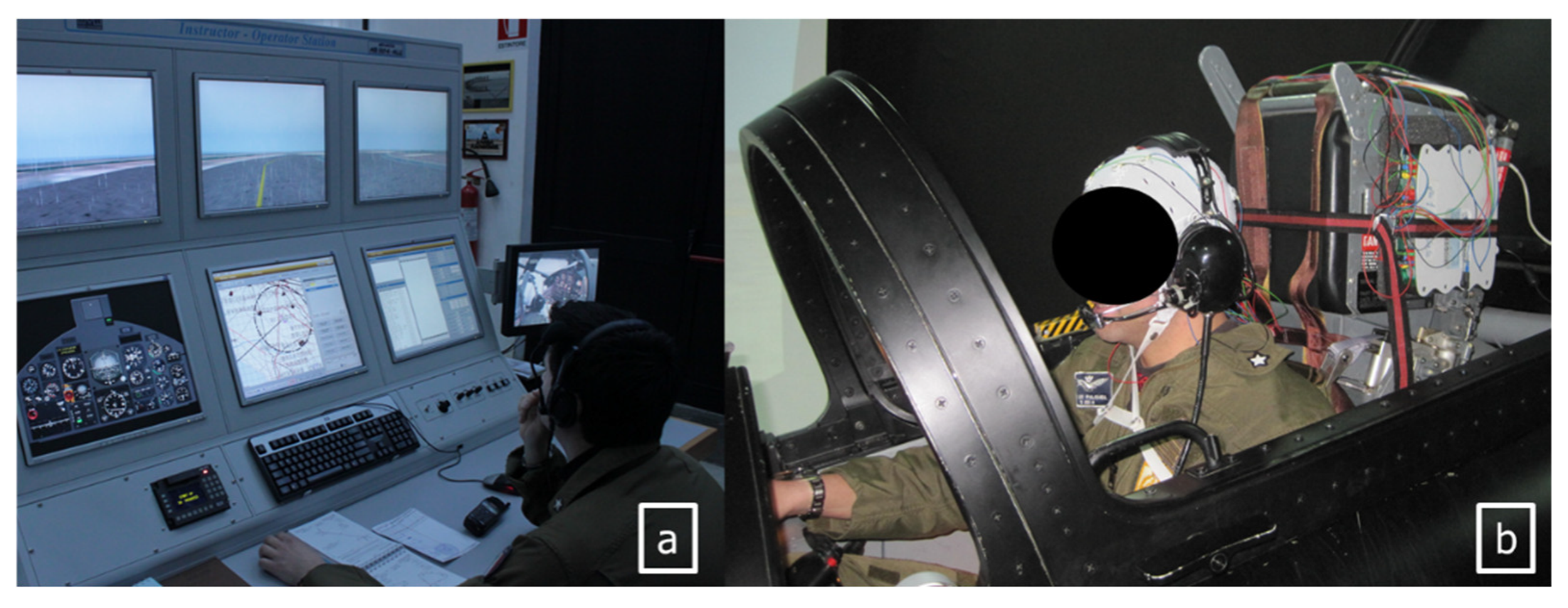
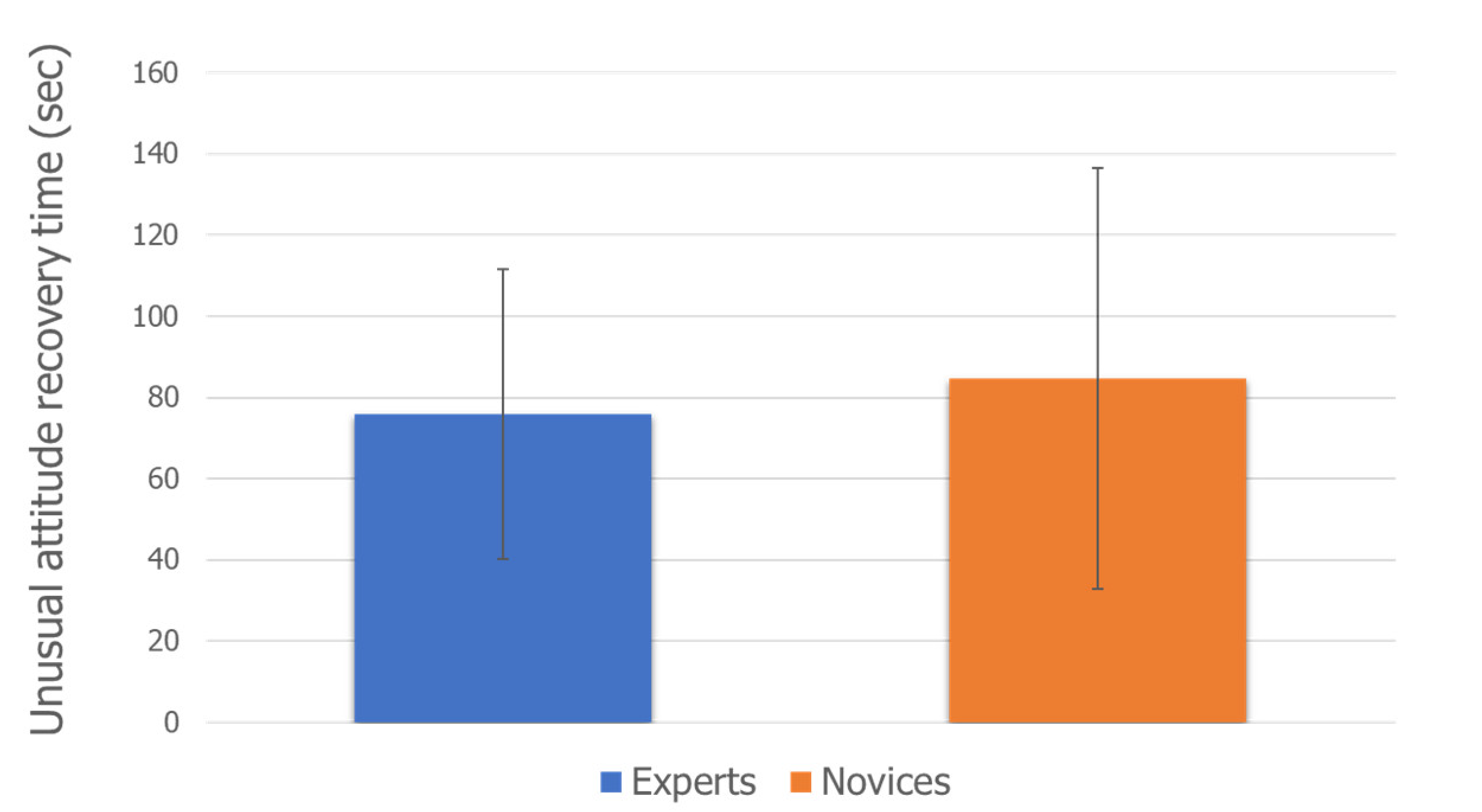
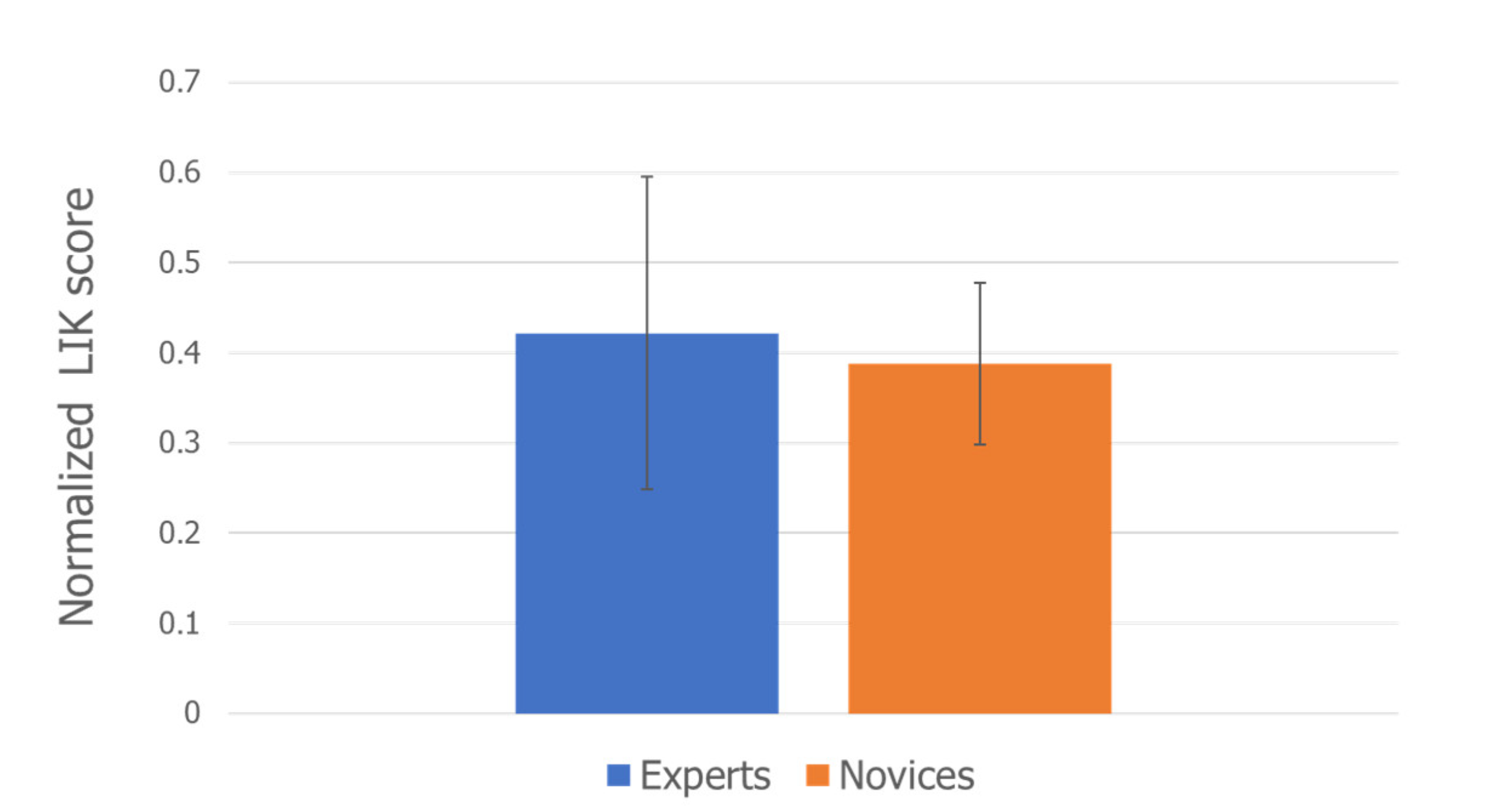


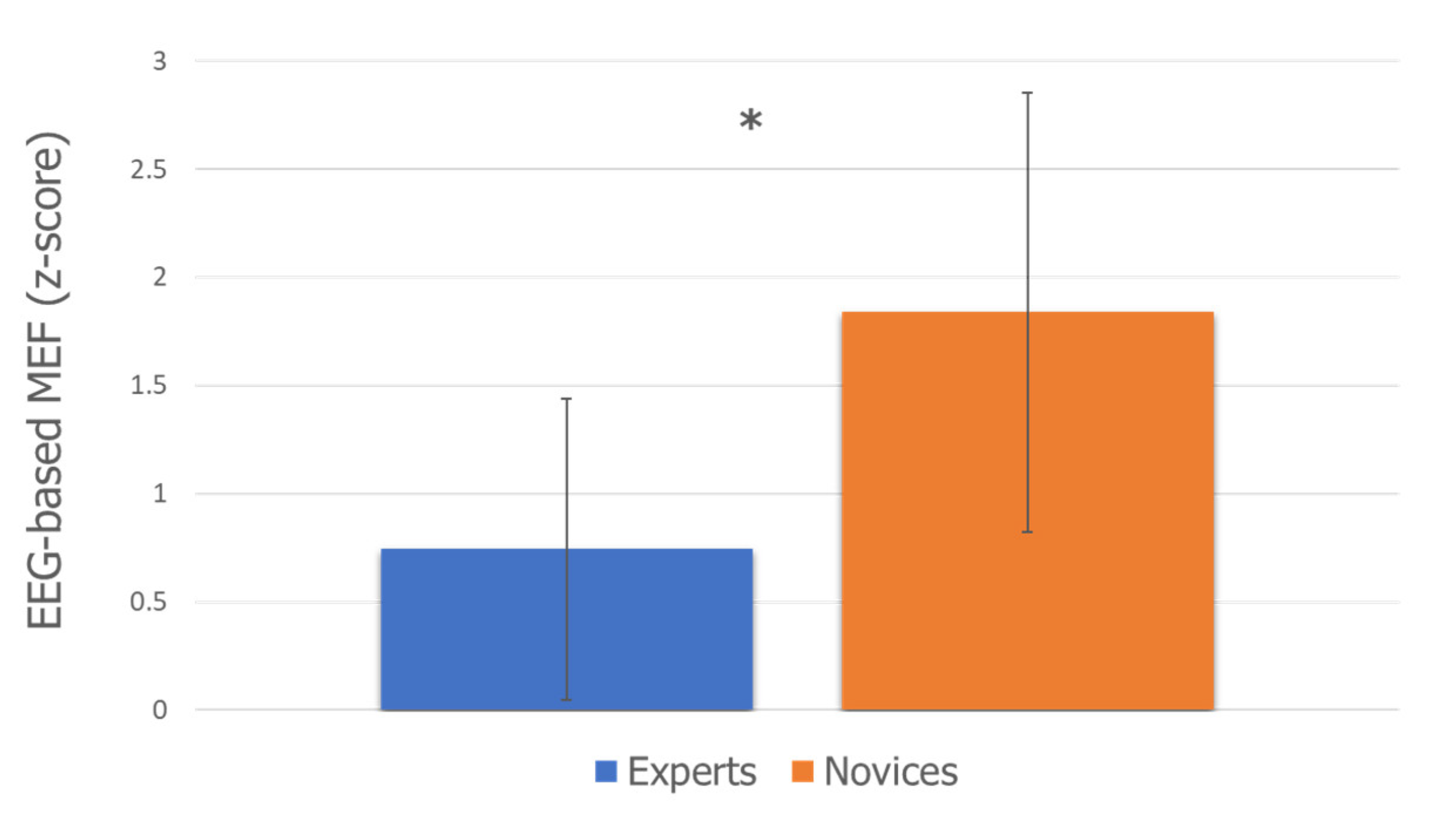
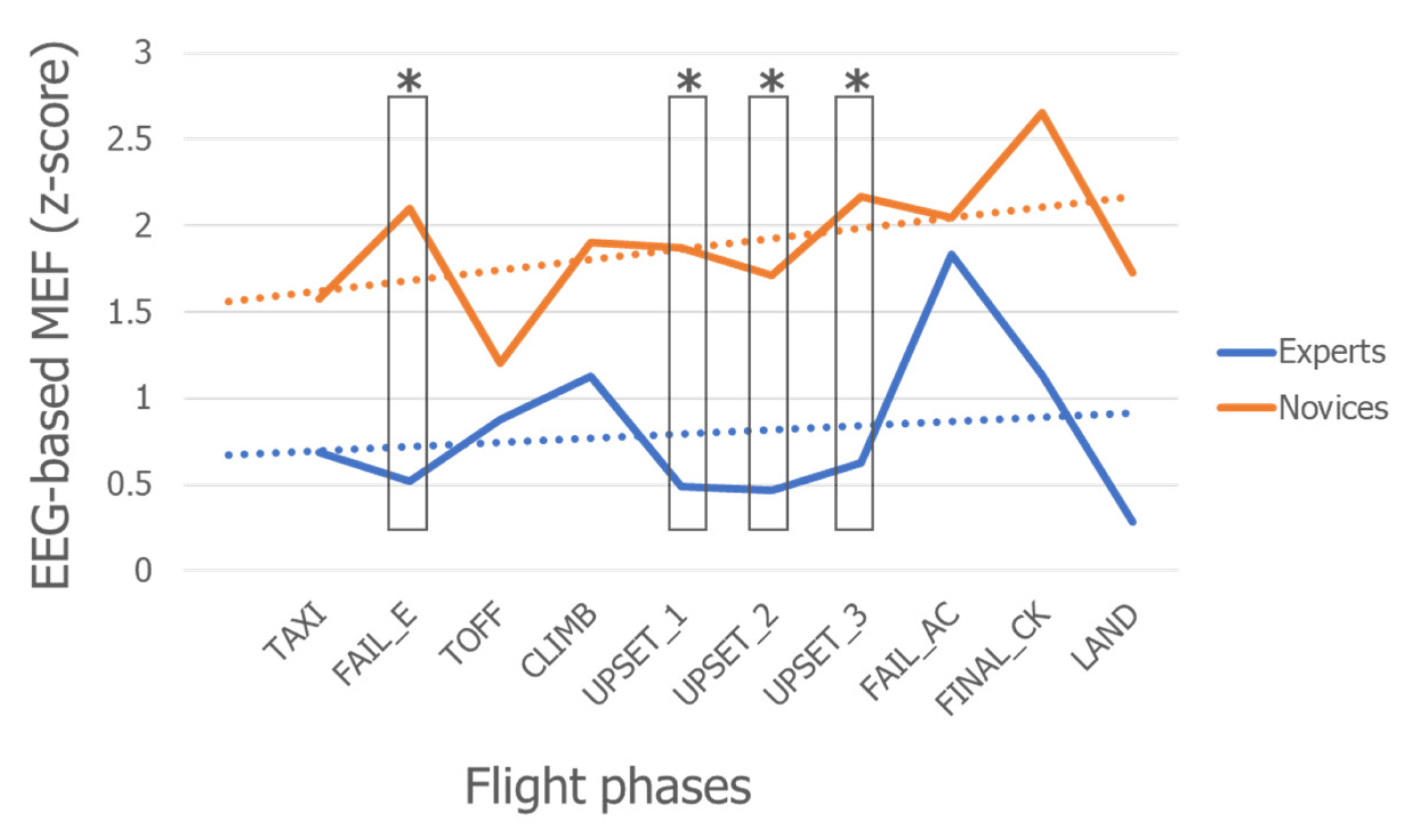


| Comparison | R | p |
|---|---|---|
| Experts–SME | 0.47 | 0.16 |
| Novices–SME | 0.61 | 0.06 |
| Experts–Novices | 0.34 | 0.32 |
| Group | R | p |
|---|---|---|
| Experts | 0.23 | 0.52 |
| Novices | 0.41 | 0.23 |
| Experts–SME | 0.47 | 0.16 |
| Novices–SME | 0.61 | 0.06 |
Publisher’s Note: MDPI stays neutral with regard to jurisdictional claims in published maps and institutional affiliations. |
© 2022 by the authors. Licensee MDPI, Basel, Switzerland. This article is an open access article distributed under the terms and conditions of the Creative Commons Attribution (CC BY) license (https://creativecommons.org/licenses/by/4.0/).
Share and Cite
Borghini, G.; Aricò, P.; Di Flumeri, G.; Ronca, V.; Giorgi, A.; Sciaraffa, N.; Conca, C.; Stefani, S.; Verde, P.; Landolfi, A.; et al. Air Force Pilot Expertise Assessment during Unusual Attitude Recovery Flight. Safety 2022, 8, 38. https://doi.org/10.3390/safety8020038
Borghini G, Aricò P, Di Flumeri G, Ronca V, Giorgi A, Sciaraffa N, Conca C, Stefani S, Verde P, Landolfi A, et al. Air Force Pilot Expertise Assessment during Unusual Attitude Recovery Flight. Safety. 2022; 8(2):38. https://doi.org/10.3390/safety8020038
Chicago/Turabian StyleBorghini, Gianluca, Pietro Aricò, Gianluca Di Flumeri, Vincenzo Ronca, Andrea Giorgi, Nicolina Sciaraffa, Claudio Conca, Simone Stefani, Paola Verde, Angelo Landolfi, and et al. 2022. "Air Force Pilot Expertise Assessment during Unusual Attitude Recovery Flight" Safety 8, no. 2: 38. https://doi.org/10.3390/safety8020038
APA StyleBorghini, G., Aricò, P., Di Flumeri, G., Ronca, V., Giorgi, A., Sciaraffa, N., Conca, C., Stefani, S., Verde, P., Landolfi, A., Isabella, R., & Babiloni, F. (2022). Air Force Pilot Expertise Assessment during Unusual Attitude Recovery Flight. Safety, 8(2), 38. https://doi.org/10.3390/safety8020038










